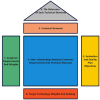A study on the design of literacy toy for children with parent-child interactions
- PMID: 40000744
- PMCID: PMC11861972
- DOI: 10.1038/s41598-025-91077-x
A study on the design of literacy toy for children with parent-child interactions
Abstract
Through semi-structured in-depth interviews, this study summarizes children's main requirements in three areas: literacy methods, literacy vehicles, and parent-child interactions. The results of the in-depth interviews were combined with the theoretical research. Fifteen user requirements were extracted and made into a KANO model questionnaire, which identified 13 valuable user requirements for children's literacy toys and prioritized the 13 effective user requirements; the AHP method was introduced to calculate the weights of the effective user requirements and derive the ranking of the requirements; the quality house model was established based on the QFD quality function configuration theory, and the user requirements were transformed into the design elements and the relative importance was calculated; the relative importance was referenced; the relative importance was calculated based on the QFD quality function configuration theory; and the relative importance was referenced to the design elements. Based on the QFD quality function configuration theory, a quality house model is established to transform user requirements into design elements and calculate the relative importance; the design practice of parent-child interactive children's literacy toy is completed with reference to the design elements with high relative importance; a children's literacy app is tested against the children's literacy toys and the children's literacy toys are evaluated in terms of the efficiency of literacy, interest in literacy, and subjective evaluation, so as to validate the feasibility of the design.
Keywords: AHP; Children’s literacy toys; NANO model; Parent-child interactions; QFD quality house model.
© 2025. The Author(s).
Conflict of interest statement
Declarations. Competing interests: The authors declare no competing interests. Ethics statement: We confirm that all methods were carried out in accordance with relevant guidelines and regulations. The study was performed in accordance with the 1964 declaration of HELSINKI and later amendments. We confirm that all experimental protocols were approved by the Ethics Committee of Nanjing Forestry University. The informed consent was obtained from all subjects and their legal guardians. The subjects are aware of the research background, process, results, and objectives, and sign a written informed consent form.
Figures












References
-
- Montessori Montessori Scientific Approach To Early Childhood Education. 350 (Beijing People’s Education, 2001).
-
- Albert Bandura. The widening education gap in developmental child care activities in the united States,1965–2013. J. Marriage Family78(1), (2015).
-
- Isao Ishii. Child care practices anteceding three patterns of preschool behavior. Genetic Psychol. Monogr.75(1), (1968). - PubMed
-
- Laura, E., Hume, Lonigan, C. J., Jessica, D., McQueen & and Children’s literacy interest and its relation to parents’ literacy-promoting practices. J. Res. Reading38 (2), 172–193 (2015).
-
- Livija Knaflič. How family literacy influences the child literacy. Psihološka Obzorja11(2):37–52 (2002).
MeSH terms
LinkOut - more resources
Full Text Sources

